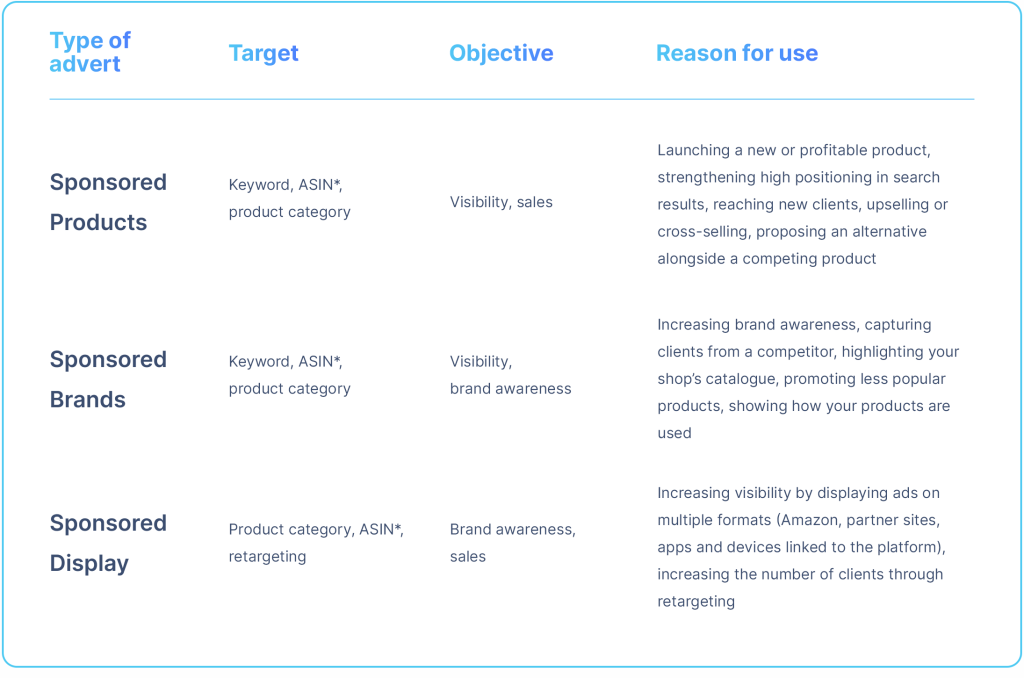
Amazon Ads: the guide to creating adverts on Amazon
Want to take advantage of the high visibility of the Amazon marketplace? Find out here how to launch your first Amazon Ads campaign and boost your sales.
Why create an Amazon Ads campaign?
Amazon: a key platform for advertisers
Who hasn’t bought something on Amazon before? Founded in 1994 by Jeff Bezos, Amazon started as an online bookseller and gradually evolved into the e-commerce titan we see today, now the world’s third-most-popular site of its kind (after Chinese sites Taobao and Tmall). Over time, it has become a vital tool for merchants, with nearly 2 million vendors from all over the world on the site, according to Amazon. However, the site’s own advertising platform Amazon Ads is often neglected in favour of better-known interfaces such as Facebook Ads and Google Ads, which are both just ahead of Amazon Ads in terms of ad revenue.
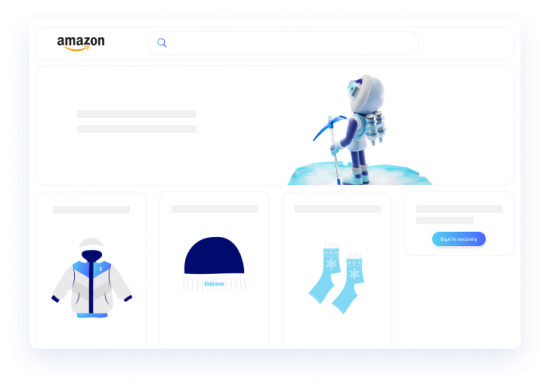
So, what is Amazon Advertising?
Amazon Advertising is the marketplace’s in-house advertising platform, also known as Amazon Marketing Services, with the term Amazon Ads being more commonly used to refer to the adverts created by merchants. The existence of this type of service doesn’t come as a surprise considering the site is used as a kind of search engine for online shopping by many. Merchants can use Amazon Ads to highlight their products or brand on results pages, partner sites, and alongside competing products. They are distinguished from organic content by using a ‘sponsored’ banner. Users of Google Ads are likely already familiar with the concept of bidding based on CPC (cost per click), or, less commonly, CPM (cost per thousand impressions).

What are the advantages
of Amazon Ads for the advertiser?

-
(Very) high visibility
Amazon is one of the highest-performing e-commerce sites in the world, with over 300 million clients on their database. The platform registers 8 million unique daily visitors in France alone, with 86% of the population having visited the site at least once (figures: BDM). This ptovides your ads with unparalleled visibility on the web.
-
Widely distributed ads
Amazon Ads are displayed on the platform itself as well as on a network of partner sites and services. For example, a vendor can showcase its ads on the video streaming service Amazon Prime, reaching its 200 million subscribers and increasing the potential visibility of their products tenfold.
-
A tool for building brand awareness
Sponsored Brands is a specific type of advert that allows advertisers to boost their brand awareness, but also to highlight the least popular products from their catalogue, and show how some of their products are used through pictures and videos. In all, it’s a great way to make yourself known among consumers.
-
Targeting options
Amazon Ads offers several targeting options. Advertisers can choose to target particular keywords, product categories, or even certain consumer demographics (particularly for retargeting), ensuring you can reach the right people at the right moment.
-
Accelerating sales
Internet users browsing Amazon typically have a strong intent: to make a purchase. Consequently, using Amazon Ads helps you reach consumers who are quite far along in their buying journey, and looking for products like those you’re offering. This is reflected in the numbers, with the average conversion rate for CPC ads reaching 9.55%, compared to 1.33% on other platforms (Sellzone).
-
The first steps, simplified
You can choose to entrust your advertising strategy to Amazon. The platform targets keywords and relevant products for you based on the merchandise you’re promoting. These “autopilot” campaigns are not only ideal for novices but also for businesses who want to explore the different parameters offered by the platform before switching to ‘manual’ mode.
-
Key indicators for analysis
Amazon provides access to various indicators and statistics reports to help you better understand the impact of your ad campaigns. A thorough analysis of your campaigns’ performance is curcial for optimising your existing ads, enchancing their impact, and planning future campaigns to achieve even better results.
Good to know
Amazon Ads is suitable for all kinds of businesses, large or small, whatever their domain may be (as long as it’s represented by an existing category on the platform). It is accessible to any merchant with an active “professional” vendor account with offers for eligible products. “Individual” accounts do not have access to Amazon Ads.
-
8 million
the number of unique monthly visitors
to Amazon in France -
600 million
the number of products
offered by third-party vendors -
310 million
the number of Amazon clients
around the world
(Sources : BDM, Fevad, Jungle Scout)
How to advertise on Amazon
Why use Amazon Ads?
Amazon’s advertising network is recommended for showcasing specific types of products. So, when is it beneficial to use Amazon Ads?

-
Promoting new products in your catalogue
Amazon ads are particularly well-suited for launching new products that you want to promote quickly. It’s an excellent way to drive traffic, sell products, and quickly obtain positive reviews from customers, which in turn boosts the natural ranking of your products.
-
Highlighting your most profitable products
Products with high margins (or high sales volumes) benefit from the visibility provided by Amazon Ads. Profits earned can be reinvested into new ad campaigns targeting less popular or recently launched products, thereby generating even more profit.
-
Selling products with high margins
The highest-priced products also yield the highest margins. Despite the higher cost per click, the return on investment still favours advertising. By featuring them alongside branded ads, you can draw more attention to your products with lower profit margins and increase your overall profit.
What ad formats are
available on Amazon?
These are the three major types of Amazon Ads:
*Amazon Standard Identification Number
Sponsored Products
“Sponsored Products” ads are the most common advertising format on the platform. They primarily operate based on keywords and aim to enhance the visibility of individual products – one per location. These ads appear in the search results (at the top of the page and/or while scrolling) and alongside competing products (at the bottom of the screen, just above the baseline). A user who clicks on a sponsored product will then be redirected to that product’s page. This allows you to reach prospective clients who are looking at similar products to the one you’re promoting either during their search (as your product blends in with those on the results page) or as an alternative when they click on another product (under ‘Related products’). Sponsored Products are very quick and easy to launch as they don’t require any work to create: Amazon generates your ads using your product list and can even handle the targeting for you.
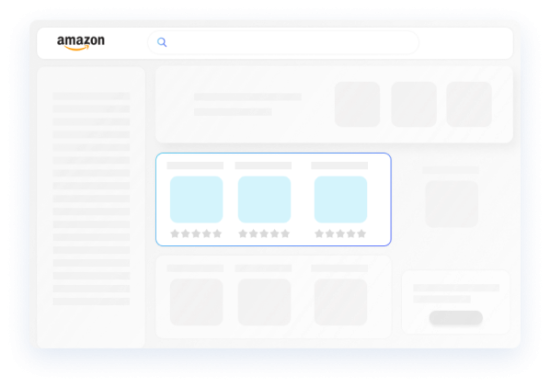
Sponsored Brands
“Sponsored Brands” ads are designed to promote your brand on Amazon, rather than individual products. Primarily based on keywords, this format is well-suited for visibility and brand awareness strategies. Clicking on one of these ads directs the user to your brand’s page, enhancing brand awareness and, consequently, drawing attention to the full range of products you offer. These Amazon Ads appear at the top of the results page, above the Sponsored Products (featuring your logo, a title or personalised slogan, an image or video, products, etc.), as well as at the bottom of the page. These ads also appear on product pages. However, Sponsored Brands ads need to be creative to capture attention and drive traffic to your store, which can be achieved through the use of personalised images and videos, promoting a range of products, and more.
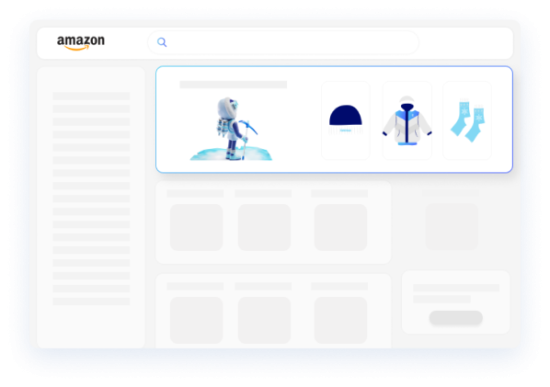
Sponsored Display
“Sponsored Display” ads take the form of banners that appear on Amazon pages and those of partner sites, as well as apps and devices linked to the platform (Amazon Prime, Kindle, etc.). These ads promote individual products by enhancing their visibility, typically appearing in the middle of search results or product pages. This format is unique because ads are generated by an algorithm based on data and audience: the most relevant ads for a particular target audience are selected as part of a retargeting strategy (targeting users who have already shown interest in a particularly product). The graphic elements of each ad are automatically generated using the resources available on the respective product page. And another thing – this format is available to brands who don’t sell on Amazon!
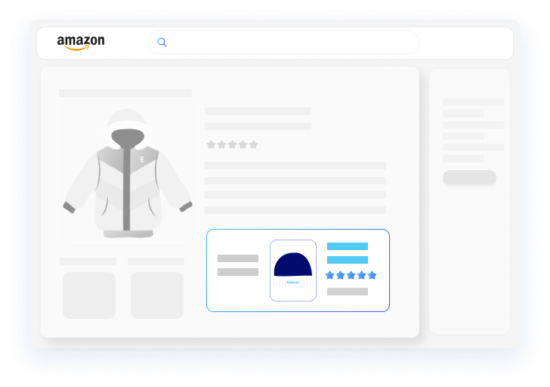
-
55%
of users
consult Amazon with the intention of making a purchase -
74%
of internet users
use Amazon to discover new products and new brands -
87%
of buyers
say they are more like to buy something on Amazon than elsewhere
(Sources: Bloomreach, Sellzone, Oberlo)
How to create your first Amazon Ads campaign
Creating your first Amazon ad campaign: where to start?
If you’re familiar with Google Ads, you’ll already have a good understanding of how Amazon Advertising works: the key steps are similar, as is the necessity to adjust your budget for CPC auctions. Before you begin, you should already have a clear idea of the products (or categories of products) you want to promote and have considered the product families within these categories, which will eventually lead to ad groups (sorted by keywords). For the rest, you should follow the steps below.

Launching a CPC Amazon Ads campaign: a step-by-step guide

-
Step 1
Sign in to your Amazon account
Log in to your vendor account on Amazon (Seller Central), click on the ‘Ad’ tab, and follow the instructions. Select the type of campaign you want to launch (Products, Brands or Display). Next, if you haven’t already, you should create your Store where your products will be displayed.
-
Step 2
Create and configure your campaign
Give your campaign a name and follow the steps according to the type of campaign you’re launching. Sponsored Products: products to be promoted, choice between automatic or manual targeting, and budget. Sponsored Brands: at least 3 products to be promoted, a logo, a title, keywords, and budget. Sponsored Display: products, target audience, auctions, and budget. You also need to choose a start and end date.
-
Step 3
Choose the type of targeting
The targeting of your Amazon Ads campaign can be either automatic or manual. For the former, the algorithm selects the keywords to target on its own – this is a good choice if you’re new to digital advertising. Manual targeting means you need to select the search terms, products, and categories yourself. This option gives you total control over your bidding.
-
Step 4
Select which keywords to target
For a campaign with automatic targeting, you can select different types of targeting for each search term: by exact or broad match, by substitutes, or by complements. For a manual campaign, you can choose between targeting by keyword or targeting by product. You can also choose negative keywords, alongside which your ads will not be shown.
-
Step 5
Define your CPC bidding strategy
You can choose between dynamic ‘downward only’ bids (where the algorithm lowers bids when the conversion potential is low) or ‘upward and downward bids’ (where the algorithm adjusts bids based on the conversion potential of each target). Lastly, there are fixed bids, in which the algorithm applies your parameters directly.
-
Step 6
Allocate a specific daily budget
CPC auctions operate based on the daily budget allocated to your campaign. You’ll need to pick a daily spending limit that Amazon cannot exceed. If any budget remains at the end of the day, it can be rolled over to the following days, up to a maximum limit of 25%. Our advice would be to set a monthly budget and then divide it into a daily budget.
-
Step 7
Keep an eye on how your ads are performing
Once you’ve launched your campaign, you should always keep an eye on how your ads or ad groups are performing. You can adjust certain parameters based on your results, such as the campaign name, targets, and CPC budget. You can even change the type of ads if you wish to change your strategy… but make sure you give them a chance to work first!
What are the key indicators to keep an eye on for the success of your Amazon campaign?
Here are a few examples of the indicators you should monitor to gauge the success of your Amazon Ads campaign!
-
Clicks
The number of times users have clicked on your ads. This indicator is adjusted every 3 days to account for any accidental clicks.
-
Impressions
The number of times your ads have appeared on pages viewed by users. This indicator is used for CPM campaigns.
-
Spending
The amount you’ve spent on a given campaign during a specific period. This is calculated by multiplying the number of clicks by the CPC.
-
Sales
The amount of money made through sales from ads. Amazon considers a ‘sale’ as a product purchased within 14 days of a click.
-
ACOS
Advertising Cost of Sales (ACOS) is the ratio of spending to revenue generated. It is a good indicator of the effectiveness of your campaign.
-
ROAS
Return on Ad Spend (ROAS) is the inverse of ACOS i.e., the ratio of revenue to spending. It indicates the potential amount generated by the campaign.
Good to know
The cost of an Amazon Ads campaign is a key factor in its success: it’s all about finding the perfect balance between the budget allocated to a campaign and the revenue it generates. We recommend starting slowly and then progressively increasing your daily budget based on the results achieved. However, you should keep in mind that the average CPC on the platform can vary depending on the category of product and time of year.
How to improve the performance
of your ads
Best practices to make your Amazin Ads campaigns more profitable
Here are a few best practices to help maximise the performance of your Amazon Advertising campaigns.

-
Set clear objectives for your campaigns
Each Amazon Ads campaign should be part of a specific strategy with clear objectives. Whether you want to increase your brand awareness or boost your sales, you need to choose the correct type of ad for your goals. If you have several distinct objectives, there’s no reason you can’t create several different campaigns.
-
Choose your keyword groups wisely
Your list of keywords should be selected with great care for a manual campaign. The terms you select will influence how your ads are displayed and how your budget is spent. Set a reasonable limit (up to 30 keywords) and remember to exclude terms that aren’t relevant in order to maximise the number of qualified clicks.
-
Take care of the product pages linked to your ads
Make sure the product pages associated with your ads are optimised. Once someone clicks on your ad, they are much more likely to make a purchase and boost your conversion rate. A good product page should include a title using keywords, a list of benefits, relevant and good-quality visuals, stock and delivery information, and the price.
-
Refine your advertising strategy bit by bit
To give yourself the best chance of success on Amazon Ads, you should adopt a ‘test and learn’ approach. Start slowly with a capped budget (10 to 30€ per day), monitor your ad’s performance, wait until you have gathered enough data, adjust your bid or target accordingly, and gradually optimise by increasing your budget.
-
Try out a few different strategies on the platform
Amazon Advertising offers a wide range of possibilities, and it’s good to be open to trying as many of these as possible–-automatic or manual campaigns, targeting by keywords and product categories, types of ads—to determine what works best for you. It’s also helpful to observe what your competition is doing.
-
Launch seasonal campaigns
Amazon’s traffic spikes considerably during the commercial periods during the year (Christmas holidays, Black Friday, sales, etc.). Be sure to adapt your campaigns by tailoring your prices appropriately, offering limited-time discounts, and promoting the right products at the right times, based on consumer behaviour.
-
Keep up to date with Amazon Ads campaigns
Ensure that you understand how Amazon Ads works to optimise your campaigns effectively. This is even more important as the platform is constantly evolving. Keep an eye on the resources available on the official Amazon Advertising site, and seek advice from your specialist digital advertising agency!
-
Two helpful tools for the biggest vendors
This guide has mainly focused on a specific category of Amazon Ads campaigns: CPC (cost per click). However, there are other, lesser-known tools available for vendors seeking higher profitability to help make their campaigns more effective. These tools are reserved for the ‘big’ sellers (those with at least several hundred items). The first is called Amazon DSP, which stands for Demand-Side Platform. This is a tool managed by an Amazon Advertising Manager, which requires a minimum budget of €35,000 to buy advertising space on a large scale. Amazon DSP gives access to four ad types: classic videos, non-clickable videos, static ads, and dynamic ads, all based on CPM (cost per thousand impressions). The second tool is Attribution, an ad tracking and measurement solution that enables you to evaluate the impact of your campaigns and the provenance of traffic on a granular level, both on and off Amazon. Think of it as Google Analytics for the marketplace!
FAQs
Amazon Ads is the name given to advertisements on the famous online marketplace, managed by Amazon Advertising. It allows vendors to display ads for their products or highlight their brand, both on the platform and on its network of partner sites and apps.
Amazon’s advertising platform offers three types of ads: Sponsored Products, to promote individual products; Sponsored Brands, to raise brand awareness and attract attention to a range of products; and Sponsored Display for retargeting. Using Amazon DSP, the biggest vendors have access to enhanced campaign management and new types of ads.
The majority of Amazon Ads campaigns are billed on a cost per click (CPC) basis: advertisers pay only when a user clicks on their ad. It’s possible to adjust the daily budget allocated to bids on keywords and product categories at any point during the campaign. Video and audio ads are billed using cost per thousand impressions (CPM).








